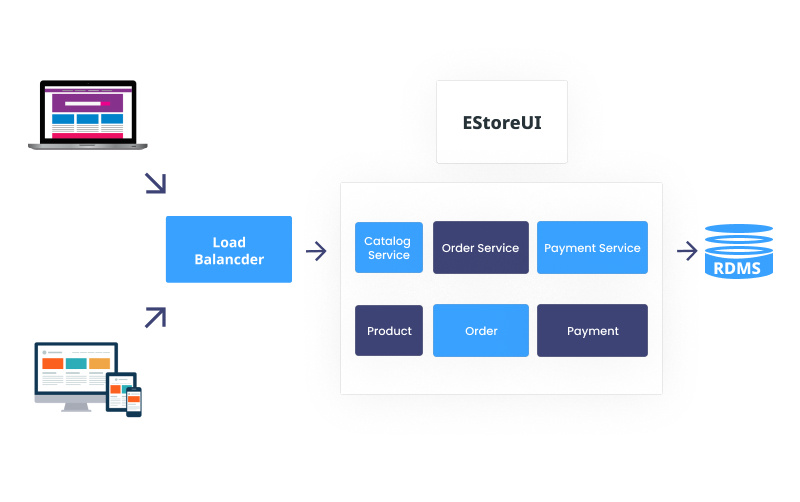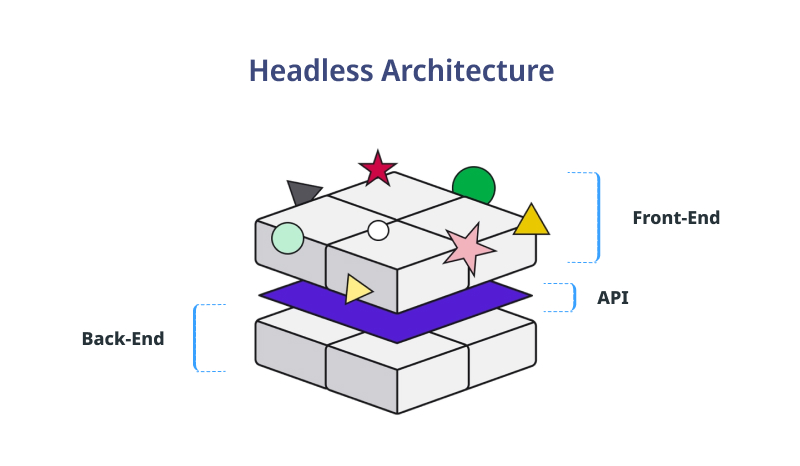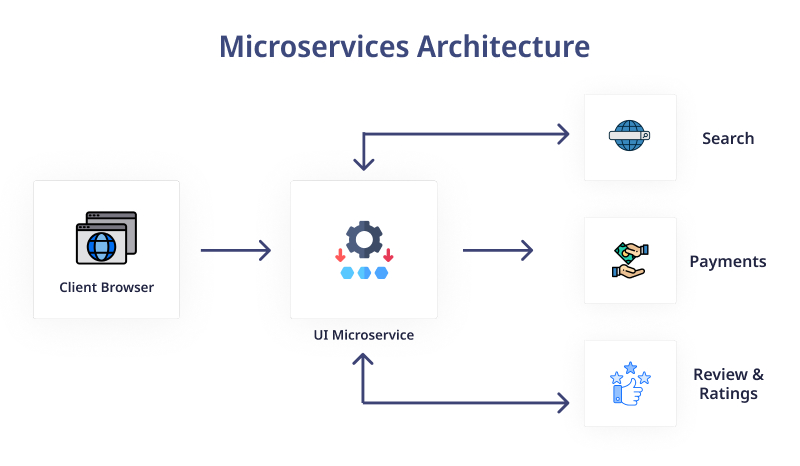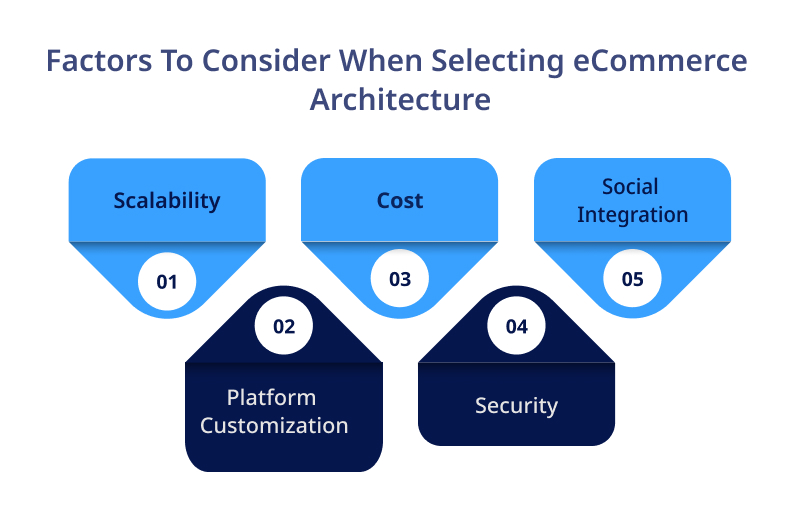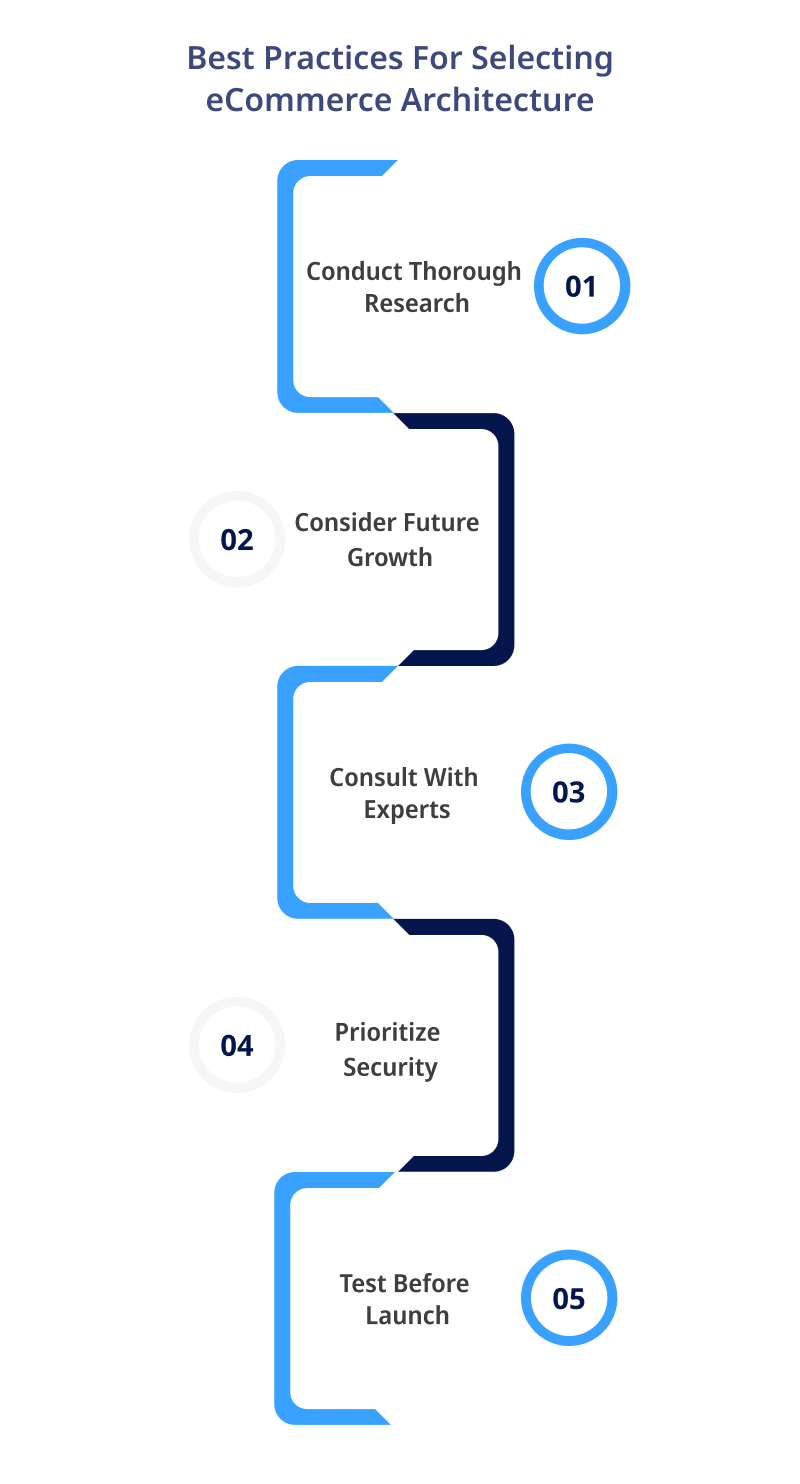“Your website is your greatest asset. More people view your web pages than anything else” – Amanda Sibley.
The quote highlights the importance of a solid online presence in today’s digital world. With the current scenario in the digital marketplace, selecting the right architecture for your eCommerce platform can either make or break your business.
According to Statista, the global eCommerce market is projected to surpass $6.5 trillion in sales by 2023, with an annual growth rate of 22.2%.
These figures indicate eCommerce’s immense potential but, at the same time, also highlight the fierce competition in the industry.
The right architecture can make or break an eCommerce business. It determines the website’s speed, scalability, security, and overall performance. With an appropriate architecture, startups can provide customers with a seamless and satisfying online shopping experience.
This blog post sheds light on different eCommerce architectures and their importance with real-world examples.
Table of Contents
From Traditional To Cutting-Edge: A Look At eCommerce Architecture Types
There are three main eCommerce architectures that startups should be familiar with. Each has functionalities, and choosing the right one for your business is critical to achieving success in eCommerce. Let’s explore each type one by one:
Monolithic Architecture
- It is the traditional way of building eCommerce websites.
- The architecture is characterized by a single, unified codebase that handles everything from the user interface to the database.
- While monolithic architecture is easy to build and deploy, it can become unwieldy and difficult to maintain as the website grows.
- It’s not as flexible as the other architectures, which makes adding new features or technologies challenging.
Headless Architecture
- The headless architecture separates the website’s front-end (the “head”) from the back-end.
- The architecture is more flexible than monolithic architecture and can handle a broader range of technologies.
- Businesses can update one without affecting the other by decoupling the front-end from the back-end.
- It is well-suited for businesses that must rapidly iterate and experiment with new technologies and features.
Microservices Architecture
- It involves breaking down the website into smaller, independent services that communicate via APIs.
- The architecture is highly scalable and allows businesses to add new features or technologies without affecting the rest of the system.
- As each service is independent, businesses can deploy changes to one service without affecting the rest of the website.
- It is more complex than the other architectures and can be more challenging to set up and maintain.
Also Read: 7 Key Benefits of Microservices Architecture for Businesses
Get in Touch with PixelCrayons Experts Today.
Factors To Consider When Selecting eCommerce Architecture
Your eCommerce architecture is the foundation upon which your entire online business operates. Therefore, it’s essential for developers to consider several factors when choosing an eCommerce architecture, including:
Scalability
As your business expands, you need to be able to accommodate increased traffic, sales, and data without any impact on the website’s performance. According to digital.com, 53% of online visitors expect eCommerce pages to load in less than 3 seconds.
Therefore, choosing an eCommerce website architecture that can handle high traffic volumes, maintain fast page load times, and accommodate future growth is critical.
Platform Customization
Customization enables you to tailor the website to match your brand’s unique identity, improve user experience, and increase sales. A flexible architecture also allows adding new features, functionality, and third-party integrations as your business needs evolve.
Cost
Startups need an architecture that aligns with their budgetary constraints. Building a custom eCommerce architecture can be expensive, and choosing a platform that can deliver the functionality and features you need at a reasonable cost is essential.
Open-source eCommerce platforms like Magento and WooCommerce offer cost-effective solutions for startups.
Security
Selecting an eCommerce architecture that can ensure secure transactions, data privacy, and protection from fraud is essential. Cybersecurity breaches can lead to a loss of customer trust, reputational damage, and financial losses.
The study by Accenture’s Cybercrime reveals that around 43% of cyber-attacks are targeted at SMBs.
Therefore, selecting an eCommerce architecture that can provide high security and data protection is crucial.
Social Integration
Integrating social media channels with your eCommerce website architecture enables you to leverage social media’s power to drive traffic, increase sales and build brand awareness.
According to DataReportal, 75% of internet users use social media to research products.
Therefore, choosing an eCommerce architecture that seamlessly integrates with your social media channels is critical.
Best Practices For Selecting eCommerce Architecture
Choosing the right architecture can make a big difference in the success of your eCommerce business.
The following are the best practices to help you make an informed decision.
Conduct Thorough Research
Research is key in selecting the right eCommerce architecture for your business. Start by identifying your business requirements and goals, then research the available eCommerce platforms. Consider the platform’s scalability, security, ease of use, and available features.
Consider Future Growth
When selecting an eCommerce architecture, it is important to consider your future growth prospects. You want to choose a platform that can accommodate your business growth and scale along your needs. Look for platforms that offer scalability options, such as adding new features or integrating with other tools.
Keep what Jeff said in mind when considering future growth, and focus on finding a platform that can best serve your customers’ needs as your business grows.
Consult With Experts
Consulting with experts can be incredibly helpful when selecting an eCommerce architecture. Look for industry experts, eCommerce consultants, or experienced eCommerce developers who can guide you through selecting a platform.
For example, PixelCrayons offers eCommerce consulting services to help startups select the right architecture. These experts can provide insights into the latest trends, industry standards, and best practices and help you make an informed decision.
Prioritize Security
Security is critical when it comes to eCommerce architecture. You want to choose a platform with robust security features to protect your business and customer data. Look for platforms that offer SSL encryption, two-factor authentication, and regular security updates.
As per a report by Pew Research Center, more than 80% of consumers worry about how companies collect their data and its use.
Prioritizing security protects your business from potential data breaches and builds customer trust.
Test Before Launch
Before launching your eCommerce site, it is essential to test the platform thoroughly. Conduct extensive testing to identify bugs, glitches, or performance issues, and ensure your site runs smoothly before going live.
Testing can be done using tools like Google Analytics, which allows you to track user behavior and identify any issues with site speed or user experience.
Additionally, you can use tools like UserTesting to get feedback from real users and identify any areas that need improvement.
Real-World Examples Of Successful eCommerce Architecture Selection
Here are some real-world examples of eCommerce businesses that have successfully selected architecture for their needs.
Example 1: Shopify
Shopify, an eCommerce platform, allows businesses to create an online store and sell their products. The architecture of Shopify is based on the monolithic model. It means all Shopify stores run on the same platform and share resources, but each store has its database.
Why is the selected architecture successful?
- It allows businesses to easily set up online stores without worrying about the underlying infrastructure.
- The shared resources of the platform ensure that the stores are always up-to-date with the latest security patches and features.
- The unique database for each store facilitates businesses to access their data and customize the store as needed completely.
Example 2: Nike
Nike, the global sportswear giant, is an excellent example of a business that has successfully implemented a headless architecture. The approach allows Nike to provide a more comprehensive eCommerce ecosystem and enhance the user experience, leading to increased customer engagement and sales.
Why is the selected architecture successful?
- Nike wants to create a unique and personalized shopping experience for its customers.
- Nike can create a dynamic user interface, personalize content, and provide a seamless shopping experience across all devices.
- Nike can also integrate with multiple third-party applications and services, which would have been complex with a monolithic architecture.
Example 3 – Amazon
Amazon, the world’s largest online retailer, is an amazing example of a business that has successfully implemented a Microservices architecture. The approach breaks down the platform into smaller, independent components or services that work together to create the final product.
Why is the selected Architecture successful?
- The architecture allows Amazon to scale its platform and add new features quickly.
- The platform is built using a variety of programming languages and technologies, which would have been challenging to manage with a Monolithic architecture.
- The architecture also allows Amazon to easily test new features and roll out updates without affecting the entire platform.
Build Your eCommerce Site With PixelCrayons
From finding the right platform to designing and developing your site, a lot goes into launching a successful online store. At PixelCrayons, we can help you build a website that looks great and functions smoothly.
Here’s how:
Custom eCommerce Solutions: We create customized solutions tailored to your unique business needs rather than offering a one-size-fits-all approach.
Responsive Design: Our developers ensure your website is optimized for every device, from desktops to smartphones.
User Experience: We create a user-friendly interface, making it easy for buyers to find what they need and make a purchase, which is crucial for converting visitors into customers.
Security: Our team utilizes the latest security measures to protect your site and customer data.
Integration With Payment Gateways: We can integrate your eCommerce site with popular payment gateways like PayPal, Stripe, and others to make it easy for your customers to complete their purchases.
SEO: Our expert SEO team ensures your site is optimized for search engines, helping you attract more visitors and increase sales.
Ongoing Support: Our team is always available for ongoing support and maintenance of your eCommerce site. From updates to bug fixes, we’ll ensure that your site is always running smoothly.
Moreover, PixelCrayons offers a quick and efficient way to hire eCommerce developers to help you build a robust and scalable eCommerce site.
Key Takeaways
Selecting the right eCommerce architecture is crucial for the success of any startup. Your chosen architecture will determine your online store’s performance, scalability, and security.
By thoroughly researching and analyzing your business requirements, you can identify the architecture that aligns with your goals and objectives.
Expert guidance from eCommerce consultants and developers can provide valuable insights on the latest trends, best practices, and technologies, helping you avoid costly mistakes and select the right architecture for your business needs.
So, take action now and connect with reputable eCommerce development services to achieve your business goals.
Get in touch with PixelCrayons professionals for all your project needs.
Frequently Asked Questions
1. What are the three components of eCommerce architecture?
Ans. The three components of eCommerce platform architecture are presentation, application, and data layers. The presentation layer is the user interface that customers interact with, while the application layer contains the business logic and processes transactions. The data layer is where all the data related to the eCommerce site is stored, including customer information, product data, and transaction history.
2. What is the physical layer in eCommerce architecture?
Ans. The physical layer in eCommerce site architecture refers to the physical infrastructure supporting the site. It includes the hardware, such as servers, storage devices, and network equipment, as well as the software that manages and monitors the infrastructure. The physical layer ensures that the eCommerce site is available and performs well, with minimal downtime and fast response times.
3. Which architecture is usually used for eCommerce?
Ans. The architecture usually used for eCommerce is a three-tier architecture, which includes the presentation, application, and data layers. This architecture separates the user interface from the business logic and the data storage, making it easier to scale and maintain the eCommerce site. It also allows for easy customization and greater flexibility, as changes can be made to one layer without affecting the others. Additionally, the three-tier architecture is well-suited for cloud-based deployments, which are becoming increasingly popular for eCommerce sites due to their scalability and cost-effectiveness.


